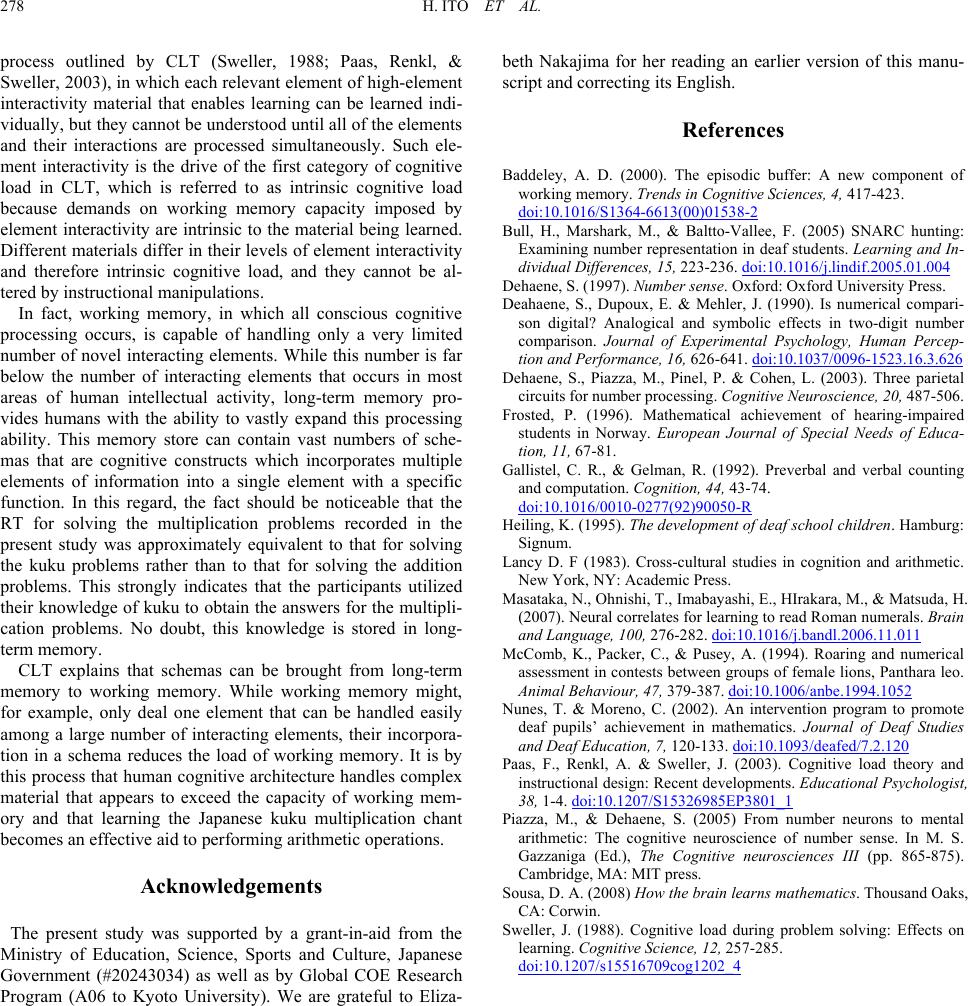
H. ITO ET AL.
278
process outlined by CLT (Sweller, 1988; Paas, Renkl, &
Sweller, 2003), in which each relevant element of high-element
interactivity material that enables learning can be learned indi-
vidually, but they cannot be understood until all of the elements
and their interactions are processed simultaneously. Such ele-
ment interactivity is the drive of the first category of cognitive
load in CLT, which is referred to as intrinsic cognitive load
because demands on working memory capacity imposed by
element interactivity are intrinsic to the material being learned.
Different materials differ in their levels of element interactivity
and therefore intrinsic cognitive load, and they cannot be al-
tered by instructional manipulations.
In fact, working memory, in which all conscious cognitive
processing occurs, is capable of handling only a very limited
number of novel interacting elements. While this number is far
below the number of interacting elements that occurs in most
areas of human intellectual activity, long-term memory pro-
vides humans with the ability to vastly expand this processing
ability. This memory store can contain vast numbers of sche-
mas that are cognitive constructs which incorporates multiple
elements of information into a single element with a specific
function. In this regard, the fact should be noticeable that the
RT for solving the multiplication problems recorded in the
present study was approximately equivalent to that for solving
the kuku problems rather than to that for solving the addition
problems. This strongly indicates that the participants utilized
their knowledge of kuku to obtain the answers for the multipli-
cation problems. No doubt, this knowledge is stored in long-
term memory.
CLT explains that schemas can be brought from long-term
memory to working memory. While working memory might,
for example, only deal one element that can be handled easily
among a large number of interacting elements, their incorpora-
tion in a schema reduces the load of working memory. It is by
this process that human cognitive architecture handles complex
material that appears to exceed the capacity of working mem-
ory and that learning the Japanese kuku multiplication chant
becomes an effective aid to performing arithmetic operations.
Acknowledgements
The present study was supported by a grant-in-aid from the
Ministry of Education, Science, Sports and Culture, Japanese
Government (#20243034) as well as by Global COE Research
Program (A06 to Kyoto University). We are grateful to Eliza-
beth Nakajima for her reading an earlier version of this manu-
script and correcting its English.
References
Baddeley, A. D. (2000). The episodic buffer: A new component of
wor kin g me mory . Trends in Cognitive Sciences, 4, 417-423.
doi:10.1016/S1364-6613(00)01538-2
Bull, H., Marshark, M., & Baltto-Vallee, F. (2005) SNARC hunting:
Examining number representation in deaf students. Learning and In-
dividual Differences, 15, 223-236. doi:10.1016/j.lindif.2005.01.004
Dehaene, S. (1997). Number sense. Oxford: Oxford University Press.
Deahaene, S., Dupoux, E. & Mehler, J. (1990). Is numerical compari-
son digital? Analogical and symbolic effects in two-digit number
comparison. Journal of Experimental Psychology, Human Percep-
tion and Performance, 16, 626-641. doi:10.1037/0096-1523.16.3.626
Dehaene, S., Piazza, M., Pinel, P. & Cohen, L. (2003). Three parietal
circuits for number processing. Cognit i ve Neuroscience, 20, 487-506.
Frosted, P. (1996). Mathematical achievement of hearing-impaired
students in Norway. European Journal of Special Needs of Educa-
tion, 11, 67-81.
Gallistel, C. R., & Gelman, R. (1992). Preverbal and verbal counting
and computation. Cognition, 44, 43-74.
doi:10.1016/0010-0277(92)90050-R
Heiling, K. (1995). The development of deaf school children. Hamburg:
Signum.
Lancy D. F (1983). Cross-cultural studies in cognition and arithmetic.
New York, NY: Academic Press.
Masataka, N., Ohnishi, T., Imabayashi, E., HIrakara, M., & Matsuda, H.
(2007). Neural correlates for learning to read Roman numerals. Brain
and Language, 100, 276- 282. doi:10.1016/j.bandl.2006.11.011
McComb, K., Packer, C., & Pusey, A. (1994). Roaring and numerical
assessment in contests between groups of female lions, Panthara leo.
Animal Behaviour, 47, 379-387. doi:10.1006/anbe.1994.1052
Nunes, T. & Moreno, C. (2002). An intervention program to promote
deaf pupils’ achievement in mathematics. Journal of Deaf Studies
and Deaf Education, 7, 120-133. doi:10.1093/deafed/7.2.120
Paas, F., Renkl, A. & Sweller, J. (2003). Cognitive load theory and
instructional design: Recent developments. Educational Psychologist,
38, 1-4. doi:10.1207/S15326985EP3801_1
Piazza, M., & Dehaene, S. (2005) From number neurons to mental
arithmetic: The cognitive neuroscience of number sense. In M. S.
Gazzaniga (Ed.), The Cognitive neurosciences III (pp. 865-875).
Cambridge, MA: MIT press.
Sousa, D. A. (2008) How the brain learns mathematics. Thousand Oaks,
CA: Corwin.
Sweller, J. (1988). Cognitive load during problem solving: Effects on
learning. Cognitive Science, 12, 257-285.
doi:10.1207/s15516709cog1202_4